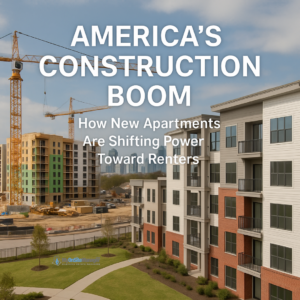After years of relentless rent increases and record-low vacancy rates, America’s rental landscape is beginning to shift and for once, renters are the ones benefiting. Thanks to an unprecedented construction boom in multifamily housing, the U.S. rental market is seeing a rare cooling effect.
Developers have delivered more apartments in the past year than at any point in the last five decades, and this surge in supply is finally easing the pressure that pushed rents to historic highs. The result? Slight rent drops, more move-in specials, and greater negotiating power for tenants.
A Record-Breaking Wave of Construction
According to Zillow data cited by NBC Los Angeles, June saw the largest number of multifamily completions in nearly 50 years. Builders have accelerated production to meet years of pent-up housing demand but as these new units flood the market, many landlords are finding themselves in uncharted territory: competition.
In cities like Austin, Dallas, and Nashville, thousands of new units are hitting the market simultaneously. With more choices available, renters aren’t scrambling to secure leases anymore. Instead, they’re comparing amenities, negotiating terms, and benefiting from a more balanced market.
The Numbers Tell the Story
The shift is measurable across multiple metrics:
-
Rent declines: The median asking rent dropped slightly nationwide by about 0.1% for one-bedroom units, 0.3% for two-bedrooms, and 2.4% for larger apartments, bringing the national average to roughly $2,010.
-
Rising concessions: About 33.2% of U.S. landlords offered at least one rent concession in July, compared to 25.4% a year earlier.
-
Regional impact: The largest rent declines are occurring in Sun Belt states such as Texas, Florida, and Georgia, where much of the new construction is concentrated. For example, Austin’s average asking rent has fallen to $1,458, one of the sharpest drops nationwide.
Why Construction Is the Game-Changer
The influx of new apartments is reshaping the economics of renting in multiple ways:
-
Increased Supply, Decreased Pressure
When more units enter the market, competition among landlords intensifies. Instead of bidding wars among tenants, landlords now compete to fill vacancies often by lowering prices or offering short-term incentives. -
Concessions Are Back
Free rent periods, waived parking fees, or discounted deposits are becoming common again something rarely seen since before the pandemic. In some cities, renters can even get a month or more of free rent on longer leases. -
Developers Target Affluent Renters and Still Feel the Pressure
While many new builds cater to upper-income renters with luxury amenities, oversupply means even those high-end units are offering deals. The market’s top tier is no longer immune to competition.
What This Means for Renters
For tenants, this is a moment of opportunity.
-
More choices, less urgency: Gone are the days of applying for a unit the same day it’s listed. Renters can afford to be selective again.
-
Negotiating power: Ask about move-in specials or discounts in many areas, landlords are more flexible than they’ve been in years.
-
Improved living standards: With more units available, renters can focus on finding homes that better match their needs whether that’s proximity to work, newer amenities, or better management.
That said, rents are still historically high. Even with minor declines, the typical rent today remains well above pre-pandemic levels, and affordability challenges persist in coastal markets like Los Angeles, New York, and San Francisco.
Implications for Property Managers and Landlords
While renters celebrate, property managers and owners must adapt to the shifting landscape.
-
Marketing and Presentation Matter More Than Ever
With more units on the market, how you present your property from listings and photos to in-person tours directly affects leasing speed. Highlight amenities, modern updates, and exceptional maintenance service. -
Leverage Technology to Stay Competitive
Use property management platforms to track leads, schedule showings, and respond quickly to inquiries. Renters expect seamless digital experiences. -
Consider Strategic Concessions
Offering a one-time discount or waived fee can reduce vacancy loss and maintain occupancy. A short-term incentive may be more cost-effective than prolonged vacancies. -
Focus on Retention
As competition increases, keeping current tenants becomes vital. Strong communication, timely repairs, and community engagement can help avoid turnover costs.
Broader Economic Impact
This building boom doesn’t just affect renters and landlords it reflects larger trends in the economy.
-
Inflation Relief: Lower rent growth helps moderate overall inflation since housing costs make up a major share of the Consumer Price Index.
-
Regional Divergence: While Sun Belt markets see relief, some areas like the Midwest and Northeast remain tighter due to slower construction.
-
Labor and Material Challenges: Developers still face higher construction costs, labor shortages, and elevated interest rates, which may slow new projects once the current pipeline is completed.
In short, today’s cooling trend could level off in the next year if construction slows again.
The Bottom Line
After years of soaring prices, renters are finally catching a break at least temporarily. The construction boom has created a rare moment where supply is meeting demand, tilting the scales toward a more renter-friendly market.
For renters, that means more choices and better deals. For property managers, it’s a wake-up call to focus on quality, service, and adaptability.
If the momentum continues, we could be witnessing the beginning of a healthier, more balanced rental ecosystem one where both tenants and landlords benefit from competition and improved housing supply.
Source: NBC Los Angeles – “A U.S. construction boom is sending rents lower and creating perks for renters”

